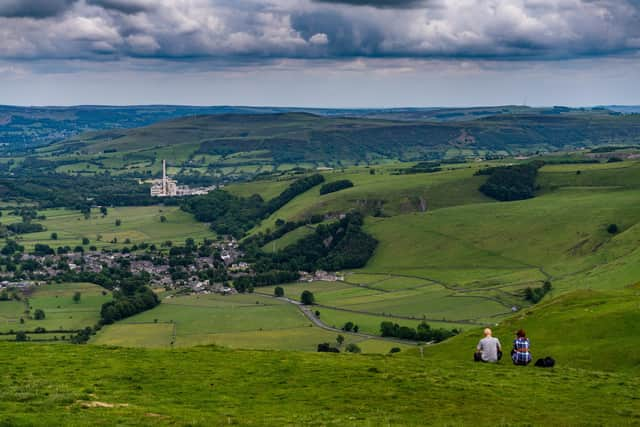High Peak industry among UK's biggest greenhouse gas emitters as Government misses climate targets
and live on Freeview channel 276
Published on Wednesday, June 28, the Climate Change Committee’s annual report to Parliament identified a lack of leadership and urgency in the transition to a low carbon economy, essential to mitigate the impact of the climate crisis.
Outgoing committee chairman John Gummer said: “Even in these times of extraordinary fossil fuel prices, Government has been too slow to embrace cleaner, cheaper alternatives and too keen to support new production of coal, oil and gas.
Advertisement
Hide AdAdvertisement
Hide Ad“There is a worrying hesitancy by ministers to lead the country to the next stage of net zero commitments. I urge the Government to regroup on net zero and commit to bolder delivery. This is a period when pace must be prioritised over perfection.”


While the criticism was aimed at national leaders, and the transition is an international challenge, many of the necessary changes will fall to particular communities where major emitters are also major employers, such as High Peak.
Initial analysis of public data by the business energy service Utility Bidder suggests that High Peak is the third highest industrial greenhouse gas emitter of all UK local authority areas.
Local industries produced an estimated total emissions of 2,416.4 kilotonnes of carbon dioxide equivalent (KtCO2e) in 2020 – the latest year for which official figures have been published by the Department for Business, Energy and Industrial Strategy.
Advertisement
Hide AdThat was beaten only by North Lincolnshire, where a significant manufacturing base contributed to 5,790.3 KtCO2e, and Neath Port Talbot in Wales, a key producer of steel and tinplate as well as 6,355.9 KtCO2e.
Advertisement
Hide AdFor comparison, fourth place on the list went to Cheshire West and Chester, with 1,954.7 KtCO2e, while the lowest emitting area of the country was Epsom and Ewell in Surrey with just 5.1KtCO2e for the year.
The figures require careful reading, not least because the pandemic made 2020 such an unusual year for economic activity, but breaking them down by sector helps to highlight the biggest sources of pollution.
Whereas some areas are home to gas and electricity supply sources, and other forms of industry, in High Peak it is the output of large industrial installations which consistently pose the biggest issues.
Advertisement
Hide AdThose local sites, predominantly associated with quarrying products, accounted for annual emissions of 2,171.1 KtCO2e in 2020, or 90 per cent of the total for the borough’s industries. As a proportion of all High Peak industrial emissions, that is higher than all but 2019 in the past 16 years.
That perhaps shows the difficulty in cleaning up activities like limestone processing compared with other emissions sources – one of the reasons why the Peak Cluster of major emitters have announced plans for a pipeline to store waste gases beneath the North Sea.
Advertisement
Hide AdTotal industrial emissions for the borough reached 2,955.1 KtCO2e in 2006, fell to a low of 2,282.1 KtCO2e in 2009, before climbing back to 2,707.2 KtCO2e in 2015 then settling around the average of 2,596.1 KtCO2e for the whole period.
Emissions from large industrial installations had been trending upwards from 2016-19, and 2020 was the first year significantly below the 16-year average (2,240.5 KtCO2e) since 2013.
Advertisement
Hide AdThough such operations are ultimately regulated at national level, High Peak Borough Council is actively seeking to address the area’s status as a major polluter, and insists local industry must be considered alongside other efforts to decarbonise.
Councillor Jean Todd, executive councillor for cimate change and environment, said: “The reason for High Peak’s ranking is linked to our geology and the resulting cement works and quarries in the area. Carbon dioxide emitted from the lime and cement industries accounts for about 40 per cent of the emissions in Derbyshire and Staffordshire, but approximately 78.5 per cent of the carbon emissions in High Peak.
“These industries are essential as we need cement to transition our infrastructure to low and zero carbon. The rest of High Peak’s emissions come from: other industry (11.3%), homes (5.3%) and transport (5.5%). In fact, High Peak’s transport and domestic figures are the second lowest in Derbyshire.
Advertisement
Hide Ad“A project, called Peak Cluster, has been launched to create a net zero future for the quarry industries by capturing the emissions at the industrial sites so they are not emitted into the atmosphere. It will then be permanently locked away using carbon capture and storage technology. It aims to prevent over 3million tonnes of emissions every year by 2030.”
Advertisement
Hide AdShe added: “These figures account for emissions only. The High Peak has large areas of moorlands which are important carbon sinks. To safeguard these important landscapes, the council has approved a Public Space Protection Order which bans the lighting of fires and the use of barbecues, fireworks and Chinese lanterns to minimise the risk of wildfires at high-risk locations. We run awareness campaigns to make people aware of the dangers and the devastating impact one rogue spark can have.
“The council is also doing a lot of work to reduce CO2 emissions generated by the services it provides - and we’re working in partnership with our communities to help them be more aware of the impact of everyday activities on climate change and the simple steps we can all take to reduce that impact. You can read our action plans on our website – www.highpeak.gov.uk/ClimateChange. You’ll also find details about our Community Climate Change Fund which offers grants to groups and organisations to help them get their green schemes and ideas off the ground and useful links to more information about climate change.”